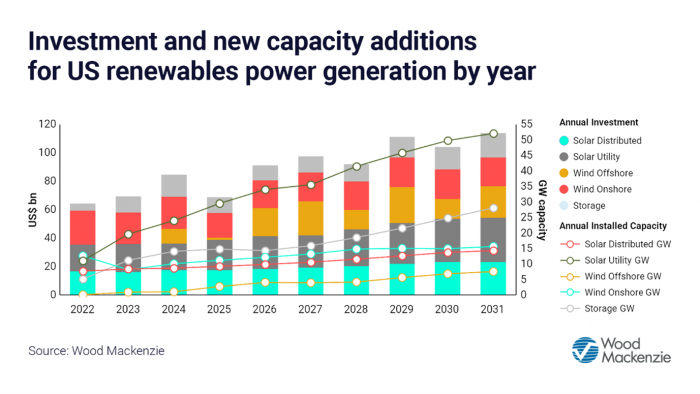
The combination of the Inflation Reduction Act incentives, the Uyghur Forced Labor Prevention Act (UFLPA) detentions and AD/CVD tariffs is resulting in new U.S. solar module manufacturing as well as a global supply network that is less reliant on China-based polysilicon and wafer supply.
For its part of this cocktail, the IRA has two key provisions. First, the act provides advanced manufacturing production tax credits (AMPC), for U.S.-made renewable equipment. Second, the act incentivizes developers to purchase domestically produced equipment by providing an additional tax credit if they meet domestic content requirement thresholds. To qualify, 40% of all equipment must be US-manufactured on projects installed before 2025.
The scope of the UFLPA goes well beyond the solar industry, and is focused on stopping of supply of any imports linked to regions of China suspected of using forced labor. Major PV module companies have had modules detained and had to undergo a lengthy process to prove that products shipped meet U.S. guidelines. Much of that supply is being released, but it remains onerous.
The circumvention decision by the Department of Commerce in the Auxin AD/CVD case, aimed at modules being produced in Southeast Asia, largely focused on those being produced with solar wafers (and other components) that came from China.

“It’s high stakes for US equipment sales, as the IRA provides incentives that cut the manufacturing cost of solar panels, storage equipment and wind towers in the US by anywhere from 4% to 30%. This, along with tariffs on some imports, potentially puts domestic manufacturing on a cost-competitive footing with imported equipment,” said Daniel Liu, principal analyst at Wood Mackenzie and lead author of Boom time: what the Inflation Reduction Act (Act) means for US renewables manufacturers’.
You can see all of that reflected in recent moves made by major PV module players as they work to better serve the U.S. market. Here’s a sample of headlines from just this month.
Q Cells
Qcells is officially putting its big investment in a U.S.-based solar PV module supply chain in motion, breaking ground on a massive new complex in its Georgia hub. All in, this is a $2.5 billion investment in the only fully-integrated, silicon-based solar supply chain from raw material to finished PV panels in the United States.
As part of this effort, Hanwha recently became the leading shareholder in polysilicon producer REC Silicon. Efforts are also underway to manufacture low-carbon polysilicon at the Norway-headquartered company’s factory in Moses Lake, Washington, which is powered by emission-free hydroelectricity. That facility will restart production in the second half of 2023.
JA Solar
China-based JA Solar announced plans to construct a 2 GW PV panel factory in Arizona, an investment of $60.5 million. The land has already been leased and the factory is expected to operations in Q4 this year. JA says the facility will produce high-efficiency PV modules for residential, C&I and utility-scale segments.
JinkoSolar
For U.S. expansion, Jinko Solar noted on a ROTH Capital Advisors webinar that it plans to open U.S.-based module manufacturing at the minimum “and is in the evaluation stage for cell capacity.” The company is waiting on guidelines from Treasury before it finalizes any plans.
In current supply, modules made with polysilicon from Hemlock and Wacker have been cleared by Customs, and Philip Shen with ROTH Capital Advisors believes 60-70% of Jinko’s fully integrated SE Asia capacity may contain Hemlock or Wacker poly, which serves the U.S. market. The company has 6-7 GW of capacity in SE Asia so this could represent ~4 GW that could be shipped to the U.S. in 2023.
“Another positive sign is that JKS has been increasing utilization rates in SE Asia to 80-90% and should be at full utilization sometime in 2023,” Shen noted.
Trina Solar
Trina Solar US alleviated concerns of new tariffs being placed on its modules by announcing a 6.5 GW silicon solar wafer facility coming online in Vietnam by mid-2023 to supply the utility, commercial & industrial, and residential solar markets in the United States.
GlobalWafers
GlobalWafers, the world’s No. 3 maker of silicon wafers for the semiconductor industry, is breaking ground on a $5 billion factory in Texas. Its parent company, Sino-American Silicon Products, is also looking expand into solar module assembly for the U.S. market, according to Forbes.
— Solar Builder magazine
Leave a Reply
You must be logged in to post a comment.